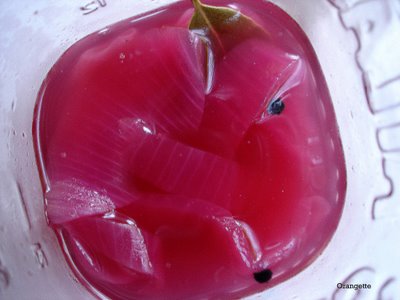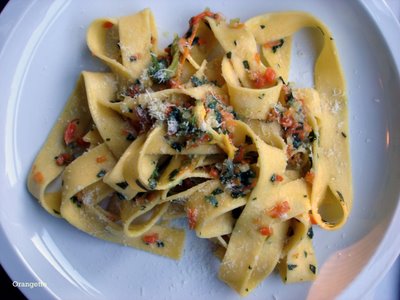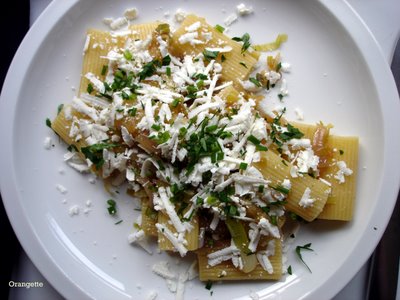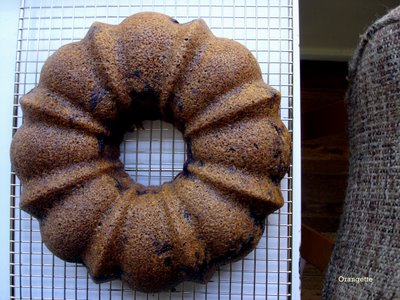Month: July 2006
A proper pickle
To some people, a pickle is a pickle is a pickle. I was one of those people until a few months ago. The pickle was the silent partner on a sandwich plate: a little green sidecar, if you will, or the dinghy that floats obediently alongside the ship. It was made of cucumber, supposedly, and still bore the seeds to prove it, albeit now sort of mushy and gelatinous. I usually just pushed it out of the way, unless the plate in question came from my father’s hand, in which case the pickle, I knew, would be a special kind that was cold and crisp and quite tasty, the sort of flavor that gets the salivary glands going. But otherwise, most of the time, a pickle was just a pickle, and nothing to get excited about.
But then along came Brandon, and he brought with him a strange, slightly unnerving need for vinegar. The man craves acidic foods like a person stranded in the desert craves water. His private world is filled, I imagine, with mirages in the shape of vinegar bottles and citrus fruits. When we met, he owned somewhere between 24 and 30 types of vinegar, a fact that he cited quite early in the wooing process, and with no small amount of pride. Today our collective pantry has happily adopted most of them, except a few stragglers that stayed behind with his old housemates in New York. There are balsamics and Sherry vinegars, champagnes and red wines, port vinegars and apple ciders, and in most cases, a few brands and ages of each. Luckily, he uses them in measured quantities for me, but when no one is looking, he’ll sip them from a spoon. For someone with a fine-tuned palate, he takes a very heavy hand to the acid on his plate. I need just enough to kick things into balance, but one seat over, he’s almost slurping at the jar of vinaigrette. And if not that, it’s a tall glass of grapefruit juice, or maybe, lately, a pickle. Or a lot of pickles.
This pickle business started a few months ago on a night out at the Boat Street Café, where we decided to try the signature rotating pickle plate. What arrived looked like a painter’s palette in shades of vinegar and salt: a few strokes of asparagus down the center, a splotch of red peppers, a pink pile of red onions, then golden raisins, button mushrooms, halved shallots, spindly farmstand carrots, cauliflower stained with curry, even prunes and sea beans, each pickle infused with its own herbs and spices. Notably, there was not a single cucumber in sight. A prickly cloud of vinegar hovered over the plate, and smelling it, Brandon looked genuinely moved. Even I got into the spirit, stealing all the prunes and most of the peppers, and putting up a little fork-and-knife fight for the last bit of cauliflower. The word “pickled” feels too dinky to describe what had happened to these vegetables: they were cool to the touch but warmly spiced, with a heady, vaporous flavor that registered sweet and sour at the same time.
But because our wallets do not permit frequent pickle-plate outings, and because Brandon, ahem, requires a regular influx of acids, he started trolling our cookbook shelves, and a week or so ago, the kitchen temporarily became a small-scale pickling plant. For a first go, he tried two varieties: one a Food & Wine recipe using a bunch of sweet baby carrots from our CSA box, and a second from our household standby The Zuni Café Cookbook, a method for pickled red onions with a handful of sweet-hot spices. Both recipes were surprisingly easy and completely painless, save for the hour or so that the house was filled with the sharp smell of hot vinegar, and then, oh, then there were the pickles.

The carrots were just so-so, but the onions were close to
transcendent: cold and juicy, with a flavor that—between its
many layers of cinnamon, clove, and chile—might best be
described as
Christmas in July, spicy and sweet. They look
soft and bendy, but once between the teeth, they give way with a
surprisingly
noisy crunch, the calling card of a proper pickle. Straight from the fridge, dredged up with a fork, a few rosy
ringlets make a handy remedy for a heat wave, I find, preferably
with a tall, curvy glass of wheat beer and a wedge of lemon.
Hell, if things continue apace, you might even find me digging
for a spoonful of brine—although I’d probably have to fight
Brandon for it first.
Pickled Red Onions
Adapted from
The Zuni Café Cookbook
This is a very special pickle. There’s no denying that the recipe has a lot of steps, but each of them is easy-peasy, so don’t be tempted to cut corners. The process of repeatedly blanching and cooling ensures that the pickled onions are softened—relaxed, if you will—but still delectably crisp, as a good pickle should be. A few picky notes about ingredients and procedure:
– Use round or flat red onions that feel nice and firm. Do
not use torpedo onions, whose layers are too thin to make for a
properly crunchy pickle.
– Use a pot made of
stainless steel or another non-reactive material, such as
anodized aluminum.
– Use wooden spoons. Aluminum
would, warns Judy Rodgers, turn the onions an “unappetizing
bluish mauve.” Nobody wants to eat a pickle that’s the same
color as your grandmother’s bath towels.
 Once your pickled red onions are ready, try serving them with a
drizzle of good olive oil, which tames their vinegar tang with a
lovely, rich finish. We like to eat them as an hors d’oeuvre,
with some fresh goat cheese or slices of sharp cheddar and some
crackers. They’re also delicious with grilled meats—hamburgers,
flank steak, chicken, whathaveyou—and would be killer, I’ll bet,
with chicken liver paté.
Once your pickled red onions are ready, try serving them with a
drizzle of good olive oil, which tames their vinegar tang with a
lovely, rich finish. We like to eat them as an hors d’oeuvre,
with some fresh goat cheese or slices of sharp cheddar and some
crackers. They’re also delicious with grilled meats—hamburgers,
flank steak, chicken, whathaveyou—and would be killer, I’ll bet,
with chicken liver paté.
4 cups distilled white vinegar
Scant 2 cups granulated
sugar
1 cinnamon stick, broken into a few pieces
4
whole cloves
2 pinches ground allspice
1 small dried
chile, broken in half if you prefer a spicier pickle
2 bay
leaves
About 20 black peppercorns
1 ½ lb. red onions
In a medium saucepan, combine the vinegar, sugar, cinnamon stick, cloves, allspice, chile, bay leaves, and peppercorns. Bring to a boil over high heat.
While the brine is heating, peel and trim the onions. Slice them into rings about 3/8 inch thick. Separate each slice into its individual rings, discarding any thin, leathery outer rings.
When the brine mixture boils, add about 1/3 of the onion rings and stir them under. They will turn hot pink almost immediately. As soon as the brine begins to simmer around the edges, about 20 seconds, stir them under again, and then remove the pot from the heat. Remove the onions with a slotted spoon, tongs, or a spider, and spread them on a platter or rimmed baking sheet to cool. They should still be firm. Repeat with the remaining onions, in two batches.
Once the onions have cooled—you can slip them into the fridge to speed them along—repeat the entire process, again in three batches, two more times, always adding the onions to boiling brine, retrieving them promptly when the brine begins to simmer again, and cooling them completely. [If you are cooling your onions in the fridge, this will not take as long as you think. It’s not so bad.] After the third round of blanching, thoroughly chill the brine. Transfer the onions and brine into jars: we used two quart-size Mason jars, which were each about two-thirds full. The most important thing is that the onions be in a container that allows them to remain submerged in the brine. Store in the refrigerator.
Age the pickles for at least a day before serving. They’re very good after 24 hours, but the flavors will have melded more harmoniously after 48. From there out, it’s delicious all the way.
Pasta, no pomodoro

At the risk of sounding as though we’re carb-loading over here—which, actually, now that I’ve typed that, sounds like a pretty tasty thing to do—I present you with my second pasta dish in as many posts. I’m having a hot summer fling with Italy, but luckily, Brandon doesn’t seem to mind. In fact, I think he’s happy about it. You will be too, when you taste this. The dish in question comes not from a cookbook, magazine, or radio show, or from a personal “Eureka!” moment at the stove, but rather from a reader comment on this very site. Last week, in response to my post on rigatoni with various permutations of onion, a very kind and knowledgeable reader named…
Read moreDinner, with a garden and lilies

I feel like such a big girl. Yesterday we did a Very Adult Thing: we went to a nursery and bought plants—herbs, at that!—for our patio. It was exhilarating, and also a little sobering. Having grown up in the suburbs of central Oklahoma—where the yards are neat and well fertilized, the flower beds carefully tended, and elaborate sprinkler systems sing sweetly at 6:00 am—I tend to equate the presence of a well-tended garden with the presence of responsible, established adults. As of yesterday, I guess that would be us, sort of—except that our garden is just six or so pots on the patio. But by god, I mean to milk those pots for all they’re worth. So last night, to…
Read moreThe leftovers business

Today I want to talk about something that I hold very dear, and for once, I don’t mean Brandon. I want to talk about something made of flour, eggs, sugar, and milk, something cooked on top of the stove and served most often with syrup. I want to talk today about pancakes—or, more precisely, leftover pancakes. A hot, steaming short stack is nice every now and then, but in my humble opinion, the best part of a pancake breakfast is the stuff that’s left on the serving platter after everyone has eaten their share. I discovered this small delight during my years of living alone, when a batch of pancake batter meant automatic leftovers. Once the little cakes were cool,…
Read more
